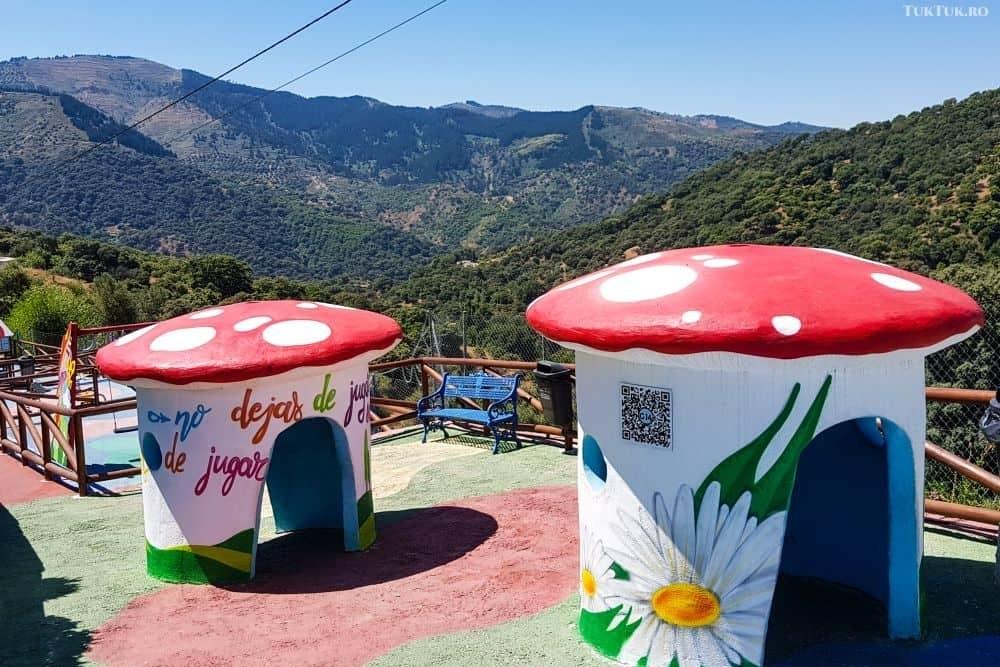Andalusia is a wonderful region and one of its main tourist attractions, besides the tremendous historical cities – Seville, Granada (take a look at best things to do in Granada in one day), Cordoba, Ronda – are the white villages, those pueblos blancos that you meet everywhere. White houses, grouped in a cluster “thrown” on a mountain or hill. But among these white villages, you have the surprise to meet a blue one in Andalusia. Juzcar is its name, and the fact that he has such a color is not accidental.
Coming by car from Costa del Sol, I made a few kilometers divergence towards Juzcar, located in Valle del Genal, on the way to Ronda and its spectacular canyon. I had read about it a few years ago, more precisely since 2011, when it became the first “Smurfs locality”. Until then, Juzcar had been one of those pueblos blancos I was talking about: a weekend destination for those who loved rural tourism and hiking.
Sony Pictures proposal

It’s just that, at some point, things have changed for the people of Juzcar. And the moment came when the company Sony Pictures proposed to the villagers to paint all their houses in blue to promote the film The Smurfs. They chose Juzcar because the surrounding hills have a lot of mushrooms, the favorite food of the blue creatures. Also, the town had a great tradition in mushroom picking and related gastronomy.
If initially, the villagers disagreed with the idea, the financial proposal was probably an undeniable one because, in the end, the City Council unanimously voted to whiten the community. With the promise that Sony revokes the houses in white after the marketing campaign is over.
Sony transformed the village completely, which became blue and studded with the famous characters of the Smurfs – Papa Smurf, Strumfette, Gargamel, Clumsy, Grouchy, and others. The company did its job, filmed what was to be filmed, promoted what was to be promoted (by the way, the movie was not very successful, not far as big as the animated series) and, in 2012, returned to keep its promise and to re-whiten everything.
It’s just, surprise! The villagers of Juzcar didn’t want to go back to white, preferring a blue life to continue. Why? The answer is obvious: 80,000 tourists visited the site, quickly taking up the tourist map of Andalusia. This is how Juzcar became known, the blue village of the Smurfs, where I parked on a hot day in July.




Juzcar, the blue surprise
Juzcar isn’t the kind of classic place that stretches across the road. It has an irregular structure of streets, and houses are erected on a wooded hill. The atmosphere was lazy, and the tourists were rare. The village seemed to be sleeping, soaked by the 35 degrees overflowing over Andalusia. But the giant smurfs you’d discover from place to place didn’t seem to be affected at all.
Most affected was the town by an announcement received a few summers ago from Belgian Pierre Culliford, known as Peyo, none other than the artist who created the Smurfs cartoons. Following a dispute between the municipality of Juzcar and Peyo, as of 15 August 2017, all the smurfs-related activities and marketing references relating to smurfs had to be discontinued. Despite an old arrangement that gave 12% of all proceeds to the Belgian artist.




In other words, Juzcar had lost its license to promote itself as the “city of the Smurfs”. There was no further information, and it seems that the problem was “solved” by renaming it “the blue village”. But the giant logo and figurines were in place, although probably until soon, there were many more. But now, even a tourist office is still open, at the entrance to the village, where you get a map with the “routes” to follow for all the objectives.
Because, beyond the drawings on the walls, the elements taken from the animation series, and the obvious local connection on the theme of the Smurfs, Juzcar boasts a church built in the 16th century, with a Cave of the Moors and with the ruins of a tin factory, which functioned in the 18th century (opened in 1731), and which was, in fact, the first of its kind in Spain. The factory had about 200 workers and employed German and Swiss technicians who had come to teach locals how to make items out of the tin.



Unfortunately, I haven’t seen many restaurants open, which will offer you local dishes or souvenir shops. It was one, but the seller seemed rather unfriendly and zealous. Or maybe it was the evil Gargamel, the Smurfs’ eternal enemy.
With the smurfs or without, Juzcar deserves a visit. It’s one of the places where kids will feel good and where adults are returning to their childhood. Or they’ll think they’re visiting an old place, which is still there before the Moorish invasion of southern Spain. And in which, as a matter of fact, El Tajarillo, a famous Andalusian bandit of the 19th century, who refused to leave the Iberian peninsula after being expelled, lived.
You may also like: How to spend a day in Casablanca, the “white city” of Morocco




